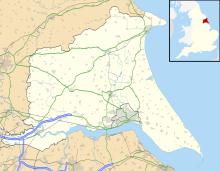This is an old revision of this page, as edited by The joy of all things (talk | contribs) at 10:24, 1 June 2016 (→History: added citation). The present address (URL) is a permanent link to this revision, which may differ significantly from the current revision.
Revision as of 10:24, 1 June 2016 by The joy of all things (talk | contribs) (→History: added citation)(diff) ← Previous revision | Latest revision (diff) | Newer revision → (diff)| This article needs additional citations for verification. Please help improve this article by adding citations to reliable sources. Unsourced material may be challenged and removed. Find sources: "RAF Carnaby" – news · newspapers · books · scholar · JSTOR (April 2012) (Learn how and when to remove this message) |
| RAF Carnaby | |||||||||||
|---|---|---|---|---|---|---|---|---|---|---|---|
| Summary | |||||||||||
| Airport type | Military | ||||||||||
| Owner | Air Ministry | ||||||||||
| Operator | Royal Air Force | ||||||||||
| Location | Carnaby | ||||||||||
| Built | 1943 | ||||||||||
| In use | 1944-1945 1959-1963 | ||||||||||
| Elevation AMSL | 10 m / 33 ft | ||||||||||
| Map | |||||||||||
 | |||||||||||
| Runways | |||||||||||
| |||||||||||
RAF Carnaby was a Royal Air Force emergency landing strip that offered crippled bombers a safe place to land near the English coast during the Second World War. It was situated 2.0 miles (3.2 km) southwest of Bridlington, East Riding of Yorkshire.
History
RAF Carnaby opened in March 1944. Unlike most RAF airfields there was a single runway, five times the width of a standard runway and 9,000 ft (2,700 m) long, lying approximately east-west to enable bombers crossing the coast an easier landing. Two other similar functioning airfields were either constructed or further developed along the east coast of England, at Manston and Woodbridge, all three providing an emergency option for wartime bomber crews. All three airfields were developed to the same pattern, Woodbridge being the first to open in November 1943. The similar runway at Manston was brought into operation in April 1944.
Along with RAF Manston and RAF Woodbridge, Carnaby was developed as an east coast emergency landing ground for bomber crews. These airfields were intended for use by returning bombers suffering from low-fuel and/or suspected damage to their pneumatic (wheel Brake) and/or hydraulic (Control surface) systems. All three airfields were equipped with a single runway, 9,000 ft (2,700 m) long and 750 ft (230 m) wide. There was a further clear area of 1,500 ft (460 m) at each end of the runway. At each of the three airfields, the runway was divided into three 250 ft (76 m) lanes. The northern and central lanes were allocated by flying control, while the southern lane was the emergency lane on which any aircraft could land without first making contact with the airfield. Over 1,400 bombers made an emergency landing at Carnaby up until the end of the war.
Embry in Mission Completedbelieved that the three emergency runways were constructed as a result of the success of the 3 mile long landing strip and flarepath at Wittering in accepting over 70 damaged aircraft from Bomber Command. The runway had been lengthened in 1940 to reduce landing accidents to nightfighter Beaufighters returning at night and in bad weather.
Fog Investigation and Dispersal Operation
Carnaby was one of fifteen airfields operating the fog dispersal system known as Fog Investigation and Dispersal Operation (FIDO). The system consisted of two rows of burning petrol one on each side of the runway, the heat from this fire raised the air temperature above the runways, cutting a hole in the fog and provided crews with a brightly lit strip indicating the position of the runway.
Post Second World War
The station closed in 1946 but was re-activated in 1953 due to the need to train pilots for the Korean War. The airfield was used as a Relief Landing Ground for No 203 Squadron (then based at RAF Driffield) but closure to flying came soon after in 1954.
RAF Carnaby was a Thor missile base from 1959 to 1963 controlled by No. 150 Squadron RAF.
Post-RAF history
RAF Carnaby was for many years used for the storage of new Lada cars and a parts distribution centre. The runway and other paved areas were also used to hold motorcycle racing events throughout the 1970s and 1980s, some of which were televised. Today it has been developed beyond recognition into Carnaby Industrial Estate although with aerial photography you can still make out the outline of the former airfield.
References
- ^ "RAF Carnaby". The Wartime Memories Project. Retrieved 16 June 2012.
- ^ Halpenny 1982, p. 39.
- Bowyer 1979, p. 219.
- Mission Completed, Air Chief Marshal Sir Basil Embry, White Lion Publishers Limited 1976, ISBN 0-7274-0260-9, pages 205-208
- ^ "Carnaby (Bridlington)". Airfields of Britain Conservation Trust. Retrieved 16 June 2012.
Bibliography
- Bowyer, Michael J F. Action Stations 1; Military airfields of East Anglia. Cambridge, Cambridgeshire, UK: Patrick Stephen Publishing, 1979. ISBN 0-85059-335-2.
- Halpenny, Bruce. Action Stations 4; Military airfields of Yorkshire. Cambridge, Cambridgeshire, UK: Patrick Stephen Publishing, 1982. ISBN 0-85059-532-0.
External links
| Royal Air Force | |||||||
|---|---|---|---|---|---|---|---|
| Ministry of Defence | |||||||
| formations and units |
| ||||||
| branches and components | |||||||
| reserve forces | |||||||
| equipment | |||||||
| personnel | |||||||
| appointments | |||||||
| symbols and uniform | |||||||
| associated civil organisations | |||||||